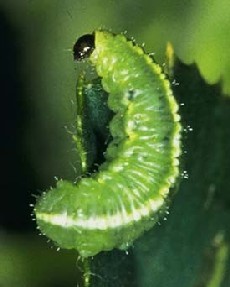Update on Alfalfa Weevil Activity
Recent increases in daily temperatures, especially in the southern part of the state, have allowed rapid accumulation of degree days for alfalfa weevil development. The table below shows degree day accumulation through 4 March. Several counties are approaching or have exceeded 200-degree days.
Table 1.
Peak egg numbers for alfalfa weevil typically occur in January and February. Hatching of eggs and onset of larval feeding usually occurs in February and March, with the peak of larval feeding occurring mid-March to mid-April (Fig 1). The recommended time to begin checking fields for larval infestations is after accumulation of 150-degree days (DD) for alfalfa weevil development from January 1.
Figure 1. Alfalfa Weevil larva
 The total DD accumulated from January 1 provides a measure of weather conditions for
development of the alfalfa weevil and can be obtained from the Oklahoma Mesonet System,
Alfalfa Weevil Model. The plant height of alfalfa is also measured at the time of
sampling to provide an estimate of the ability of the crop to withstand feeding damage.
These two items are used, along with the number of weevil larvae shaken from each
30-stem sample of alfalfa, to make decisions regarding the need for spraying as directed
on the recommendation table found in EPP CR#7177, Scouting for the Alfalfa Weevil
in Oklahoma.
The total DD accumulated from January 1 provides a measure of weather conditions for
development of the alfalfa weevil and can be obtained from the Oklahoma Mesonet System,
Alfalfa Weevil Model. The plant height of alfalfa is also measured at the time of
sampling to provide an estimate of the ability of the crop to withstand feeding damage.
These two items are used, along with the number of weevil larvae shaken from each
30-stem sample of alfalfa, to make decisions regarding the need for spraying as directed
on the recommendation table found in EPP CR#7177, Scouting for the Alfalfa Weevil
in Oklahoma.
Because of the unpredictability of weather patterns, scouting is one of our best tools for identifying what’s happening in a particular field and in a particular area of the state. If adult activity, egg hatch, and larval feeding develops early enough, we may still be able to rely on cold weather events to help with suppression. However, if the current warming pattern persists, populations can increase quickly.
We’ll keep you posted as the season develops.

